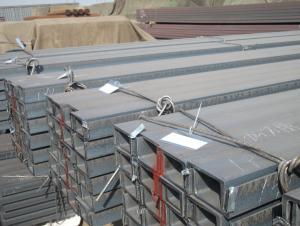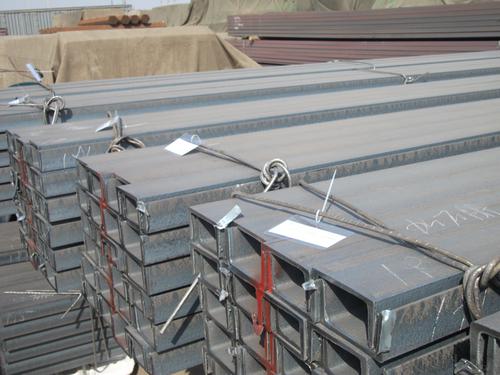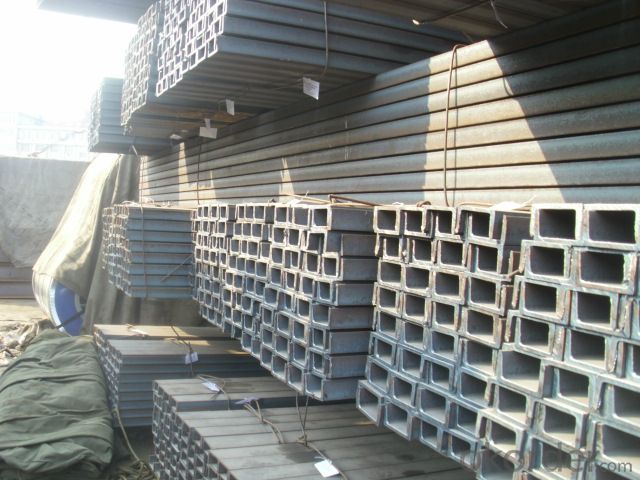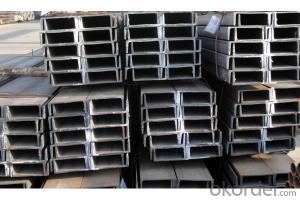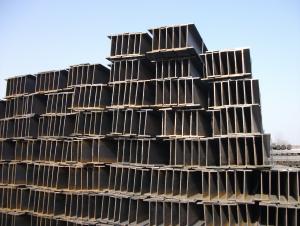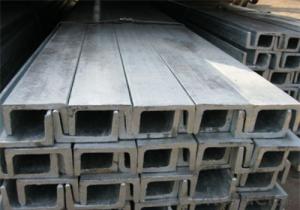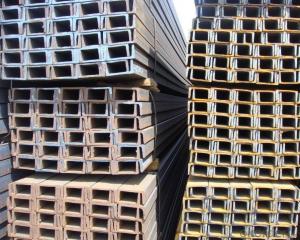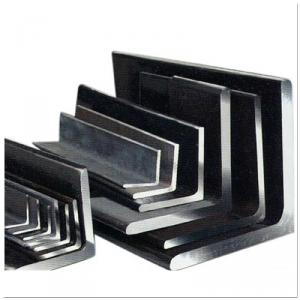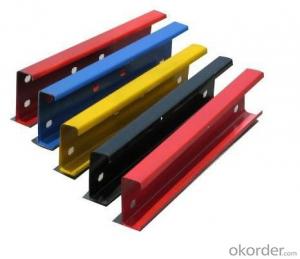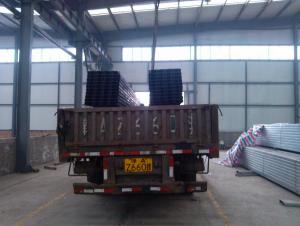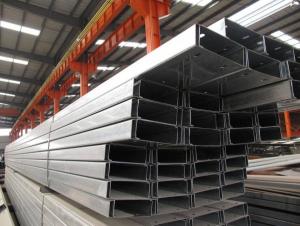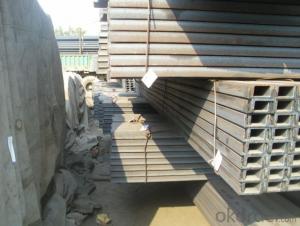UPN Steel Beams
- Loading Port:
- Tianjin
- Payment Terms:
- TT OR LC
- Min Order Qty:
- -
- Supply Capability:
- 100000 m.t./month
OKorder Service Pledge
OKorder Financial Service
You Might Also Like
Specifications of UPN Channel Steel:
1.Our UPN Channel Steel has lots of advantages, just as followings:
a) At reasonable price and good quality.
b) To be convenient in construction and to save much time and labor.
c) The length of UPN can be manufactured according to customer’s requirements.
d) The UPN Channel Steel has strong mechanical strength.
e). The UPN Channel Steel possesses various kind of fittings, through which it is suitbal for many combinations.
f) Our UPN Channel Steel is attractive in appearance as well as beautiful in design
g) Free from slotted punching
2. The detailed sections of our UPN Channel Steel can be found in table-1
UPN U CHANNEL | Standard h | Sectional b | Dimension s | t | Mass: Kg/m |
| (mm) | (mm) | (mm) | (mm) |
|
80x45 | 80 | 45 | 6.0 | 8.0 | 8.64 |
100X50 | 100 | 50 | 6.0 | 8.5 | 10.6 |
120x55 | 120 | 55 | 7.0 | 9.0 | 13.4 |
140x60 | 140 | 50 | 7.0 | 10.0 | 16.0 |
160x65 | 160 | 65 | 7.5 | 10.0 | 18.8 |
180x70 | 180 | 70 | 8.0 | 11.0 | 22.0 |
Table-1
Note: we are definitely good at manufacturing and supplying UPN channel steel as per S235JR. Also, we are willing and able to provide our customers UPN channel steel in other sizes, which depends on customers’ concret requirements for the quantity.
3. The chemical composition of UPN Channel Steel as per S235JR is shown in the table-2
Alloy No | Element(%) | ||||
C | Mn | S | P | Si | |
S235JR | 0.12—0.20 | 0.3—0.7 | ≤0.030 | ≤0.030 | ≤0.20 |
Table-2
4. The mechanical property of UPN Channel Steel as per S235JR is shown in the table-3-1 and table-3-2
Alloy No | Yielding strength point( Mpa) | |||
Thickness (mm) | ||||
≤16 | >16--40 | >40--60 | >60--100 | |
≥ | ||||
S235JR | 235 | 225 | 215 | 195 |
Table-3-1
Alloy No | Tensile strength (Mpa) | Elongation after fracture(%) | |||
Thickness (mm) | |||||
| ≤16 | >16--40 | >40--60 | >60--100 | |
≥ | |||||
S235JR | 340--510 | 24 | 23 | 22 | 27 |
Table-3-2
Applications of UPN Channel Steel:
The UPN Channel Steel can be applied to construction of warehouses, workshops, sport stadiums and car parks etc.The hot rolled channel steel belongs to carbon structural steel which is applied to in the field of construction and machinery.In details, the hot rolled channel steel is usually used for arch-itechtural structure, and they could be welded in order to support or hang a vari-ety of facilities. They are also usually used in combination with I beam. Generally,the hot rolled channel steel we supply must possess perfect welding property, riveting property and mechanical property and so on.
- Q: How do steel channels contribute to fire resistance in buildings?
- Steel channels contribute to fire resistance in buildings by providing structural stability and preventing the collapse of the building during a fire. They act as reinforcements within the building's framework, enhancing its ability to withstand high temperatures and preventing the spread of fire. Steel channels are designed to retain their strength even when exposed to extreme heat, which helps to maintain the structural integrity of the building and allows occupants more time to evacuate safely.
- Q: Can steel channels be powder-coated?
- Yes, steel channels can be powder-coated. Powder coating is a popular finishing technique used to apply a durable and protective layer of color to various metal surfaces, including steel channels. The process involves applying a dry powder onto the steel channel and then heating it to create a smooth and even coating. This coating not only enhances the appearance of the steel channel but also provides additional protection against corrosion, UV rays, and general wear and tear. Powder coating is an environmentally friendly and cost-effective solution for steel channels, making them more resistant to scratches, chipping, and fading.
- Q: How do steel channels contribute to sound insulation?
- Steel channels can contribute to sound insulation by providing a rigid structure that helps to minimize the transmission of sound waves. When steel channels are used in the construction of walls or ceilings, they create a framework that can be filled with sound-absorbing materials such as insulation or acoustic panels. This combination of the steel channels and sound-absorbing materials helps to dampen and absorb sound energy, reducing the amount of noise that can pass through the structure. Additionally, steel channels can also be used to create double or staggered wall systems, which further enhances sound insulation by creating air gaps that act as barriers to sound transmission. Overall, steel channels play a crucial role in sound insulation by providing a solid foundation and structure for sound-absorbing materials and creating a barrier that prevents sound from traveling through the building.
- Q: What are the different methods of installation for steel channels?
- Steel channels can be installed using various methods, depending on the desired outcome and specific application. Here are a few common methods: 1. Welding: Welding is a commonly used method for installing steel channels. It involves melting the metal and allowing it to solidify, creating a strong and durable connection. This method is ideal for heavy-duty applications. 2. Bolting: Another installation method is bolting. This involves using bolts, nuts, and washers to secure the steel channel to a surface or structure. Bolting allows for easy disassembly and reassembly, making it suitable for situations where adjustments or modifications may be required. 3. Adhesive bonding: Adhesive bonding can be used to install steel channels in some cases. Industrial adhesives or epoxy are used to bond the channel to another surface, providing a reliable connection. It is often used in conjunction with other methods like bolting or welding. 4. Fasteners: Steel channels can also be installed using screws, nails, or rivets. This method is typically used for temporary or lightweight applications, as it may not provide as strong of a connection as welding or bolting. 5. Interlocking systems: Some steel channels are designed with interlocking systems that allow for easy connection and secure installation without the need for additional methods. These systems feature grooves or slots that allow the channels to fit together like puzzle pieces, creating a stable connection. To determine the most appropriate installation method for steel channels, it is important to consider the specific requirements of the application and consult with professionals or refer to industry guidelines.
- Q: What is the weight per foot of various steel channel sizes?
- The weight per foot of various steel channel sizes can vary depending on the specific dimensions and thickness of the channel. Steel channels are typically designated by their depth, width, and weight per foot. For example, a 6-inch by 8.2-pound-per-foot steel channel will weigh approximately 8.2 pounds per linear foot. Similarly, a 10-inch by 15.3-pound-per-foot steel channel will weigh approximately 15.3 pounds per linear foot. It is important to note that these weights are approximate and may vary slightly based on the specific manufacturing process and tolerances. Additionally, different steel alloys or grades may have slightly different weights per foot. Therefore, it is always recommended to consult the manufacturer's specifications or reference tables for the exact weight per foot of a specific steel channel size.
- Q: What are the different methods of connecting steel channels?
- There are several methods of connecting steel channels, including welding, bolting, and using mechanical fasteners. Welding involves fusing the channels together using heat, creating a strong and permanent connection. Bolting involves using bolts and nuts to secure the channels together, allowing for disassembly if needed. Mechanical fasteners, such as rivets or self-tapping screws, are also used to connect steel channels, providing a secure and efficient connection.
- Q: What does channel 160 type 140*40 steel pipe mean?
- Channel steel is a long strip steel with a cross section, and a section shaped steel with a cross section.
- Q: Multiple and calculation methods for channel 12
- The theoretical weight calculation of channel steel and the theoretical weight calculation of steel are kg (kg), and the basic formula is:W (weight, kg) = F (basal area mm2) * L (length m) * P (density g/cm3) * 1/1000 (steel density: 7.85g/cm3)
- Q: Can steel channels be used for curtain wall framing?
- Yes, steel channels can be used for curtain wall framing. Steel channels are often used in curtain wall systems for their strength and durability. They provide structural support and are able to withstand the load and pressure from the curtain wall system. Steel channels are versatile and can be designed to fit the specific requirements and dimensions of the curtain wall. Additionally, steel channels can be easily fabricated and installed, making them a popular choice for curtain wall framing.
- Q: Can steel channels be used in soundproofing applications?
- Yes, steel channels can be used in soundproofing applications. Steel channels are often used as part of soundproofing systems to create a barrier against noise transmission. They can be installed between walls, floors, or ceilings to reduce sound transmission and improve acoustics in a space. Steel channels are known for their structural strength and stability, making them an effective choice for soundproofing applications.
Send your message to us
UPN Steel Beams
- Loading Port:
- Tianjin
- Payment Terms:
- TT OR LC
- Min Order Qty:
- -
- Supply Capability:
- 100000 m.t./month
OKorder Service Pledge
OKorder Financial Service
Similar products
Hot products
Hot Searches
Related keywords
